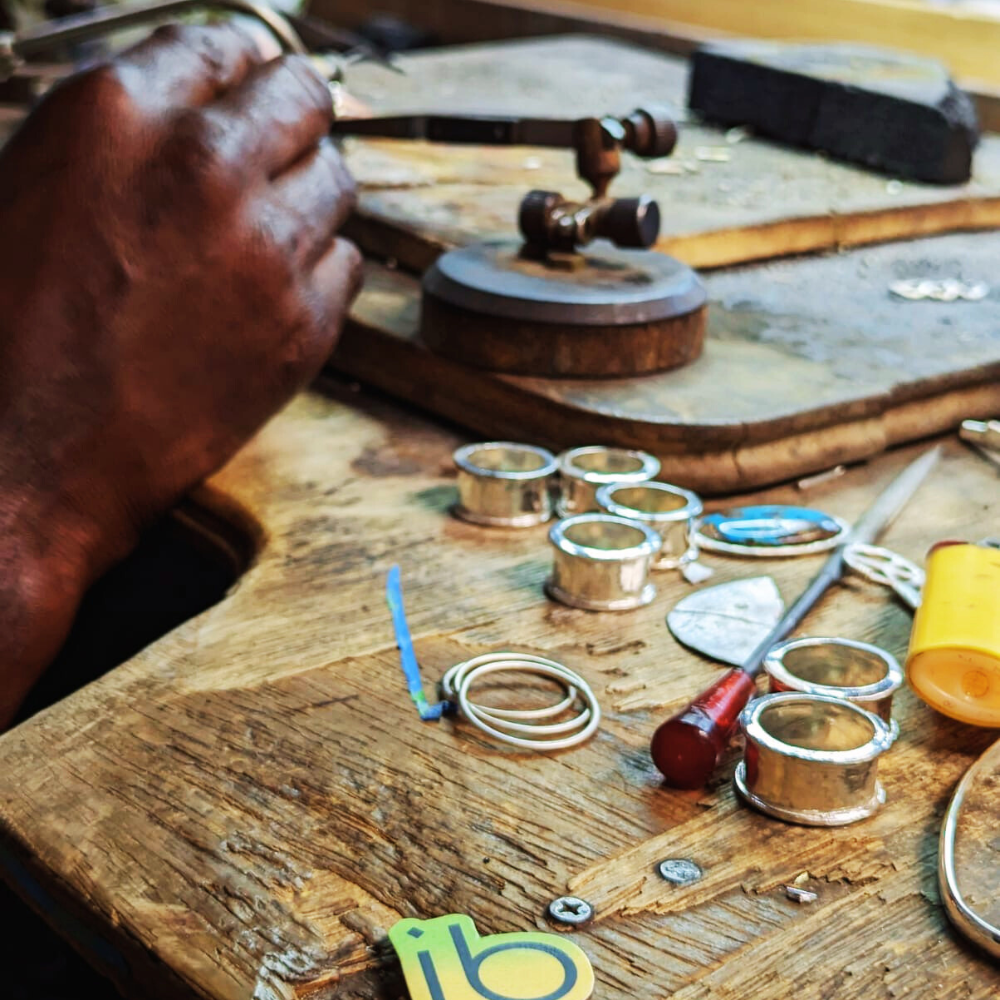Your Cart is Empty
Collections
History of the West Indian Bangle
History of the West Indian Bangle
The West Indian bangle is a common accessory here in the Caribbean, because its complicated history is intricately tied up with the story of our people.
Today, the West Indian bangle is such a staple of Caribbean life that it’s a traditional gift for new babies. Many people, however, know that it was also once referred to as a “slave bangle.”
How did this iconic jewelry design transform from a tool of oppression to a symbol of prosperity and joy? The West Indian bangle is a story of perseverance, hope, and strength.
Manilla: Status Symbol and Currency
A precursor to the modern West Indian bangle is the manilla. Once popular in many West African countries, the manilla is a metal bangle with a narrow opening, much like the modern design, and was most often made of gold or copper (known, in the 1800s, as “the red gold of Africa”).
Manillas were a popular form of currency in many African countries by the early 1800s. They could buy everything from basic goods in a marketplace to burial plots and brides. Manillas were so common that early foreign traders, such as the Portuguese, imported their own to purchase spices, ivory, and more.
By the time the transatlantic slave trade came to West Africa, the use of manillas to purchase enslaved people was common and well known. European slave ships came loaded with imported manillas to fuel the Maafa (“great tragedy” in Kiswahili, refers to the period of the Transatlantic Slave Trade where historians estimate that close to 12 million Africans were captured and brought to the Americas).
But many of the manillas, or slave bangles, survive today, and it’s clear to see that the design is similar—but not identical—to the modern West Indian bangle. Further, chattel slavery didn’t allow an enslaved person to keep anything, especially not currency or jewelry. So how did these bangles come across the Atlantic and how did the design evolve?
From Indian Bayra to Guyanese Gold Bracelet
Metal bangles were not, of course, unique to the countries of Africa. Many countries and cultures the world over were also forging gold and other metals into bangles. India, for example, has a rich history of gold bangles—called bayras.Some Indian bangles, dating as far back as manillas, were hammered in the same basic design: a tight oval with a narrow opening for the wrist.
After the 1833 Slavery Abolition Act in England, British sugarcane plantations in the new world found themselves in a labor crisis. The need for manual labor in the tropical Caribbean climate coincided with a poor economy in India, and the Indian indenture system was born—bringing more than half a million Indian laborers to the West. Two of the largest populations eventually settled in Guyana, South America, and the Caribbean islands.
Here, the bangle designs, meanings, and traditions melded as a new way of life was forged. They also evolved with the unbreakable spirit of the people who now call the islands their home, localizing the design with the cocoa pod-inspired bulbs on the open ends of the bangle.
Today, the West Indian bangle is still known as the Caribbean bayra, the cocoa pod bracelet, or the Guyanese gold bracelet.
The West Indian Bangle Today
In many ways, a stack of beautiful bangles on a woman’s wrist is almost a symbol of wealth and prosperity again. The shimmer and jangle of a collection of delicate bangles echoes the luxury of a carefree, joyful spirit.
And the most popular style—as part of a collection or a solo piece, on women and men alike—is a simple West Indian bangle. Today, it is worn as a celebration of Caribbean culture.
Caribbean, the bangle’s modern design harmonizes a variety of influences, with an embellishment of its own to honor nature and her provision.
The West Indian bangle is so much a part of Caribbean culture that it is a traditional gift for new babies. The small bracelets are usually kept as an heirloom long after the child outgrows it.
West Indian Bangle History
The West Indian bangle is informed by the familiar West African manilla and inspired by the Indian bayra, but has since become a symbol in its own right.
Gold cocoa pod bracelets are made and sold all over the world. If you’re going to get one of your own, however, get the real thing: a simple, stunning West Indian bangle, in gold or silver, hand-hammered by a local Caribbean artisan, Whealan Massicott.
Our West Indian bangles are forged from sterling silver and/or 14k gold. Wear it proudly as an islander, a guest, or a fan of the creative strength inside each one of us.
ib designs creates handcrafted unique West Indian bracelets that make the perfect arm adornment for you or your special person. Get your West Indian bangle today.
1 Response
Leave a comment
Comments will be approved before showing up.
Also in Feel Good Blog

Elements of the Soul: A Retreat to Recharge in Dominica
If you’ve been longing for a true reset, our Dominica yoga retreat—Elements of the Soul—is designed to help you restore balance and reconnect with yourself. Known as the “Nature Island of the Caribbean,” Dominica offers the perfect backdrop for a healing journey with its lush jungles, waterfalls, and natural hot springs. This Caribbean retreat blends daily yoga, meditation, and heart-centered practices with nature adventures and farm-to-table nourishment. It’s more than a getaway—it’s a chance to slow down, practice self-care, and recharge your soul in one of the most beautiful, untouched destinations in the world.

🌿 Blog Post: Introducing the Amani Collection — Jewelry for Your Inner Peace
Our new Amani Collection is a graceful celebration of our interconnectedness — a reflection of the calm we can cultivate and carry with us daily.

ib Workshop: Where all the Magic Happens
Ever wonder where all our jewelry is created? Take a behind-the-scenes look at where the magic of our jewelry comes to life!





















Joni H.
August 02, 2024
I absolutely love my WIB and i appreciate you posting the origins of these bangles/bracelets. Thank you again